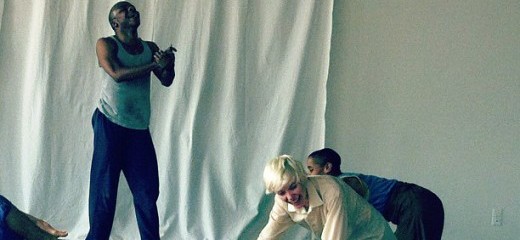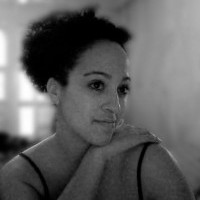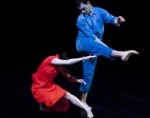
Down the Rabbit Hole with Kate Watson-Wallace
by Julie B. Johnson
Are you a back-seat choreographer? Have you ever watched a performance and fantasized about what you might do differently? If so, you would have felt right at home in the audience of last Monday’s Scratch Night at the Painted Bride Art Center. Scratch Night is presented by the Live Arts Brewery (LAB) - an artistic research and development incubator of Philadelphia Live Arts Festival and Philly Fringe. LAB describes the event as “...a free monthly event where selected artists share experimental ideas at various stages of development. It is open to all who want to be a part of the artistic process.” In January, Kate Watson-Wallace graced the venue, letting viewers “remix” her choreography in her latest endeavor, “Mash Up Body.”
The term “performance” is problematic for Watson-Wallace. She finds the phrase “performance installation” more inclusive - and I think it accurately describes the evening. Installations of other genres, including visual arts or non-time based art forms, allow for an up-close view of the work. In this case, audience members were allowed special access into Watson-Wallace’s creative process and given carte blanche to make a few changes.
In “Mash Up Body,” Watson-Wallace explores the layering of identity and memory. Using the body as the site for investigation, she plays with different “movement states” (from a sassy walk to a withdrawn slouch) and jumbles them up into an intentionally bland palate that can be easily manipulated into new variations. She credits the tradition of Headlong Dance Theater - a well-established Philadelphia-based dance theater company - with opening her up to the process of creating new versions based on the memory of older versions, leading her “down the rabbit hole” (think about what happens when two mirrors face each other). What comes out on the other side is anyone’s guess. What is unclear to me is whether the outcome even matters to her; perhaps the journey is the thing.
As the audience members found their seats and made small talk with their neighbors, five female dancers stood in a loose clump on stage, casually chatting, warming up by hopping and lightly stretching, and by marking through some movement phrases. Traditional performance conventions were not sacred here. In fact, Watson-Wallace made sure to inform us that nothing about this work is precious to her, that everything is fair game.
The first of seven different iterations of the piece began. Non-distinct pop/electronic dance music with heavy bass kicked in as two dancers raked their fingers through their hair and others shimmied and bopped their heads to the beat. In femme-bot fashion, the group joined in synchronized head whips, high-heel walks and pelvic pulses evoking images of 1980’s Robert Palmer music videos. They broke formation and charged around the stage with sassy limp-wristed gestures in repeated directional patterns. Suddenly, the music stopped, and they filled the silence with sounds of kissing, giggles, and gagging. The mash-up of these particular activities was subtle yet humorous, and the audience responded with uproarious guffaws.
Craig T. Peterson, Director of LAB and Philly Fringe and our guide through the various phases of the evening, introduced us to the LAB Fellows - one of whom would fashion the next iteration of the work by creating a variation on the original on the spot. The audience chose LAB Fellow Lee Ann Etzold through the use of the old-fashioned applause-o-meter. A self-proclaimed non-dancer, her version was minimal yet hilarious, especially when she placed her boots center stage to represent the other dancers. We later learned that she’d been less concerned with remembering the original piece than recalling what she had done thirty seconds earlier so she could repeat it. She found herself in a cycle of remembering and inventing. This, Watson-Wallace pointed out, highlighted what can happen to our minds when we watch performance. We might feel the urge to remake what we’re watching in accord with our own aesthetic preferences.
Peterson announced that it was time for us, the audience, to “mess this piece up.” We chose filters, or elements of the original work to revise. Audience members were eager to get involved. They volunteered numerous suggestions of which Kate chose two. In this iteration, dancers were instructed to play with masculine/feminine gender roles, and they had to perform the whole piece using only a small 8x8 area of the stage. Movement became exaggerated as the dancers turned to stereotypes (fist bumps, violent pelvic thrusts, slow snaking body rolls), and the lack of space heightened the interaction between the performers. The dancers had to problem-solve in the midst of the dance.
The next five versions involved different configurations of LAB Fellows, audience members, and the cast, and were just what Watson-Wallace said they would be: versions of previous versions, impressions of impressions, using different filters suggested by the audience to remix the work. Everything everyone did became part of the vocabulary for the next rendering of the work. Some moments were truly inspired, some fell flat. Unfortunately, getting a laugh seemed to become the focus, especially during the last version. Those previously subtle giggles and pretend upchucks became maniacal laughter and violent vomiting. We journeyed through the rabbit hole and found ourselves amidst an unintelligible frenzy of slapstick gags. While it seemed like great fun for the people involved (if I hadn’t been there on official business, I would have joined right in), I’m not sure how it served the piece or helped Kate to achieve a better understanding of her work.
Whether or not the evening lived up to Watson-Wallace’s expectations (if she had any at all), it was powerfully engaging from start to finish. Audience member Rori Smith explained that the process “created a personal investment for us.” The audience inserted ideas and got to see how they played out. We were invited to share feedback that wasn’t filed away on some paper-slip survey - it was instantly absorbed into the creative process. What Watson-Wallace will ultimately do with it is a mystery, one that this audience member is eager to uncover. I’ll be back at the Painted Bride to see the fuller version of “Mash Up Body” when she presents it this March.
“Mash Up Body,” Kate Watson-Wallace, The Painted Bride Art Center, January 7, 2013; upcoming, March 4, 2013.
By Julie B. Johnson
January 13, 2013





.png)


